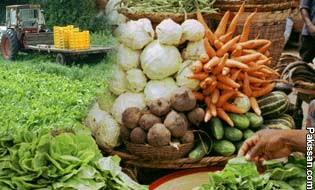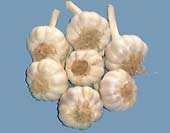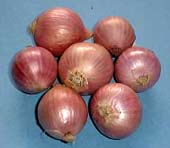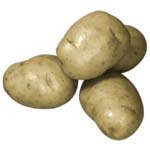|
Improving the
marketing system of vegetables
By Dr All
Muhammad Khushk and Muhammad Ibrahim Lashari
Vegetable consumption in Pakistan is low. People in the upper
income strata consume above average, while the bulk of rural
and a large percentage of urban population consume little
vegetables.
 The per capita consumption estimate is about 35kg annually
which is far below the minimum level necessary for basic
nutrition. However, the growing family income is expected to
increase the demand for vegetables as well. The per capita consumption estimate is about 35kg annually
which is far below the minimum level necessary for basic
nutrition. However, the growing family income is expected to
increase the demand for vegetables as well.
For sustainable agriculture development an efficient marketing
system is essential which not only affects the producer's
income but also shapes the consumer's welfare.
Market efficiency does not depend only on farm production cost
and yields but on the mechanism, wherein a product reaches to
a consumer from the farm gate. The factors influencing the
market efficiency include their perishable nature, quality,
price and location.
In small towns assembly markets are situated near farm-gates
where marketable surplus is brought in by farmers. Traders,
shopkeepers and retailers participate as buyers in these
markets. Most transactions involve small quantities.
Traders here are not approved by any government agency,
although in some cases town committees charge an entry fee.
Traders don't maintain record of transactions. Pricing is
based on negotiations between the trader and the farmer.
 Since quantities are small, farmers don't mind small
difference in prices. However, for large quantities they
prefer wholesale markets, or compare prices before selling
their produce. Better transport facilities and availability of
large quantities of marketable surplus have made it feasible
for farmers to take their produce to wholesale markets. Since quantities are small, farmers don't mind small
difference in prices. However, for large quantities they
prefer wholesale markets, or compare prices before selling
their produce. Better transport facilities and availability of
large quantities of marketable surplus have made it feasible
for farmers to take their produce to wholesale markets.
In an assembly market, agents perform work on commission by
charging 10 per cent on sale revenue from sellers. They do not
provide lodging, boarding, transport, telephone and
entertainment facilities.
Usually they maintain contact with the commission agents in
wholesale and terminal markets and receive price information
from agents in various wholesale markets. On receiving a
demand from a wholesale or terminal market, they arrange that
quantity from agents for supply.
Wholesale markets located in a district town or a major
sub-division town such as Hyderabad and Lahore are main
assembly centres for vegetable surplus of surrounding areas.
These have better storage, transportation, communication and
working conditions for both buyer and seller.
Traders have permanent offices and auction floors here for
transactions. Commission agents also provide lodging and
boarding facilities to contractors and producers. Members of
market committees monitor activities of traders in these
markets.
Traders are required to keep records of their daily
transactions and report them to their respective committees.
Commission agents, wholesalers, retailers, shopkeepers and
weighing men are also registered and licensed by these
committees.
These measures have resulted in improvements. For example,
replacement of old weighing gadgets with the semi-automatic
scales are convenient and transparent for both buyer and
seller.
Terminal markets are situated in urban centres. The Karachi
market is one of the best examples. Most agricultural
surpluses are ultimately routed to this market. Foreign trade
is one reason. Traders here are usually the wholesalers who
supply farm produce to firms and industries for processing and
to retailers and shopkeepers.
 Marketing channels are concerned with the "marketable" or
"marketed" surplus of farm commodities that enter into
circulation and exchange. The purpose of exchange of
commodities for money and vice versa is to have access to a
variety of products. Marketing channels are concerned with the "marketable" or
"marketed" surplus of farm commodities that enter into
circulation and exchange. The purpose of exchange of
commodities for money and vice versa is to have access to a
variety of products.
Here, agricultural marketing channels refer to the outlets or
routes through which commodities reach the final consumer. The
existing vegetable marketing channels are producer, commission
agent, wholesaler, and retailer.
The constraints to private sector activity in the marketing
chain include bureaucratic delays and corruption; poor law and
order, a slow, expensive and corrupt legal system; poor
transport and communications, and poor dissemination of market
information.
Regulation of these markets is governed by the Agricultural
Produce Markets Act of 1939; under this Act a market committee
comprised of the government officials and representatives of
growers, traders and consumers. A market committee is
established for every notified area.
It is responsible for arranging open auctions, supervision of
weight and measures and prompt payments, licensing of all
traders, allotment of shops or trading floors for new
entrants, dissemination of market information and levying of
market fees or taxes.
The government levies fees on agricultural produce, 15 per
cent of which are retained by the local market committee with
the aim to improve physical infrastructure of the market.
Collection of it is contracted out to private agencies that
compete in an annual open auction. In reality, political
influence and bribes determine the award of the contract.
After obtaining contract, money is recovered by charging
higher-than-the-government- scheduled fee.
The fee collecting agencies collude with local police in
'intimidating traders reluctant to pay such higher rates.
Trucks are held at checkpoints resulting in the spoilage of
produce.
Growers who transport and market their own produce are
officially exempt from the market fees, but in practice pay
the same as contractors. It is known that a proportion of this
revenue is passed on to top hierarchy, while the fee
collecting individuals are changed regularly.
All traders (growers are exempt) engaged in purchase, storage
or sales of agricultural produce in notified market area are
required to be licensed by the local market committee.
The power to issue, renew and cancel licenses provides means
to obtain bribe from traders. This particularly applies to new
entrants. The official criteria for obtaining a license are
solvency, past experience, competency with no criminal
convictions. But, in practice this is determined by a bribe,
family and social ties and support from local commission
agents association.
 Similarly, vegetable export is regulated and licensed by the
Export Promotion Bureau (EPB). It was found during a survey
that there were few permanent and licensed exporters, while
others were operating on temporary and informal basis in
collusion with the EPB. Similarly, vegetable export is regulated and licensed by the
Export Promotion Bureau (EPB). It was found during a survey
that there were few permanent and licensed exporters, while
others were operating on temporary and informal basis in
collusion with the EPB.
Shops and auction floors in wholesale markets are the property
of market committees. Limited in number, they tend to be fully
occupied by commission agents and wholesalers.
New entrants to the market have to invest significant capital
in a "goodwill" payment to existing shop holders (amount paid
vary among markets, ranging from one to 2 million rupees) as
well as a bribe to the committee for allotment.
Entry of new people as commission agent needs a license from
the market committee. Once a license is received, the agent
must register himself with the commission agents' association.
A wholesaler requires a license, space, experience and
contacts to enter into the market. Retailers do not require a
license but experience is more important. There are a large
number of retailers and as a result each one faces strong
competition in buying and selling of produce.
They usually buy fruit from wholesalers on credit for one to
two days. A new retailer has to provide a third party
guarantor to wholesalers to become entitled to buy produce on
a credit basis.
Vegetable exporters require a license, experience, contacts
and capital to enter into the business. An export license is
the first condition for entry into the business. It was
reported by exporters that there was no difficulty in
obtaining a license from the Export Promotion Bureau (EPB).
A new entrant has to apply on the prescribed form along with
the official fee. In practice a license will be ready within a
week but some commission agents pay a bribe to the concerned
official to obtain the license the same or next day.
However, barriers to entry for different market intermediaries
reveal that the existing marketing system is potentially
competitive with few barriers resulting from state
intervention. Regulation of entry through licensing is weakly
enforced in the country.
Marketing margins are the differences between prices at two
market levels. Marketing margin analysis is commonly used to
examine the differences between producer and consumer prices
for the same quantity of a commodity.
Margins represent the price charged by marketing agencies for
all services - buying, packing, transportation, storage and
processing. Under competitive conditions market margins are
the result of demand for services and equal to the minimum
cost of services provided plus normal profit.
To measure market margins, data on price were obtained at
different stages. It is difficult to come up with a unique
solution for the price to be used. There are many
complications in formulating the standard price of vegetable
which can be summarized as: (a) day to day variation of
prices, (b) varietal differences, (c) grade differences, (d)
price variation over the season, (e) the basis for averaging
various grades and varieties and (f) price differences in
consumption and production areas.
Such problems have been resolved by collecting prices which
may cover most of the above conditions. The price of onion,
chilly and potato was collected on per 40kg basis. The tomato
price was collected on a per crate basis; the average weight
per crate is about 14kg.
 Prices were collected weekly throughout harvesting season from
assembly and wholesale markets and from different market
intermediaries. At the same time information on retail price
was collected from the same city. Simple averages for all
prices for different market intermediaries were calculated. Prices were collected weekly throughout harvesting season from
assembly and wholesale markets and from different market
intermediaries. At the same time information on retail price
was collected from the same city. Simple averages for all
prices for different market intermediaries were calculated.
It is believed, particularly by growers, that middlemen take
away large share of the profit. To investigate, absolute cash
margins (ACM) for each market has been estimated.
The ACM or price spread is the difference between the price
paid and received by each specific market intermediary. For
vegetable producer's ACM was calculated as the sale price of
the orchard and the total quantity harvested by the
contractor.
The producer's share in consumer's rupee (on final retail
price) was calculated on per bag 100kg in case of onion,
chilies and potato and per crate/14kg in case of tomato. When
producers sold their onion produce, the maximum producer
received as his share in consumer's rupee was 64 per cent
during early season and minimum 52 per cent in late season.
Tomato producers received 64 per cent in early season and 57
per cent in mid season. Chilly producers on average received
65 per cent in consumer's rupee and potato producers 56 per
cent.
Courtesy:The
DAWN |
Pakissan.com;
|